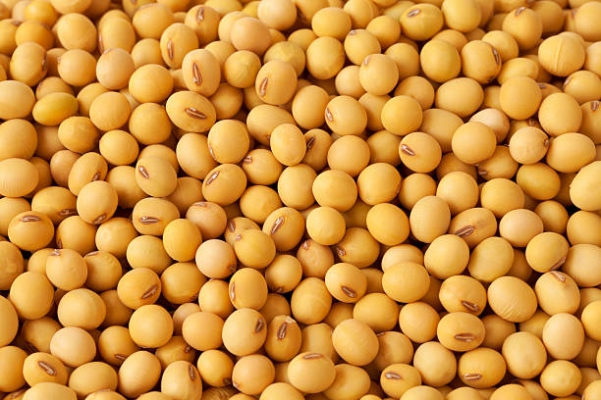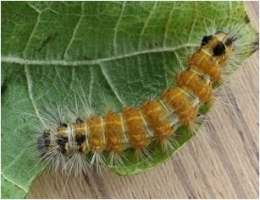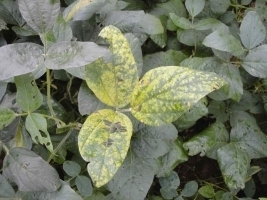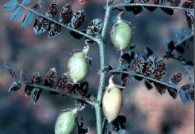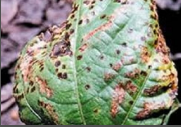Brag: The variety is taken from America. The variety is released in India in 1969. It has medium long plant (75-85cm), white flowers, brown legumes, yellow grains and hilum is black in color. The weight of grains is 15gm per 100seeds. The variety is resistant to bacterial spot and yellow mosaic virus. The variety matures in 120 days. The average yield is near about 8-10qtl per acre. The seeds contain 40% protein and 20% oil content.
Ankur: Developed in 1974 for northern plain areas and mid-India. It has long plant (80-90cm). It has white flowers, deep green color leaves, yellow seeds, and medium sized seeds (12gm/100seeds). The variety is resistant to bacterial spot. The variety matures in 130-135 days and it gives an average yield of 8-10qtl/acre. The seeds contain 41-43% protein content and 21-23% oil content.
Alankar: Released in 1977. It has medium long plant (60-80cm), white flowers; leaves are deep green in color and have yellow grains. Seeds are large size i.e. 15-16gm per 100 seeds weight. The variety is resistant to yellow mosaic virus and bacterial wilt. The variety is suitable for early and late sowing. The seeds contain 40-42% protein content and 20-22% oil content. The variety matures in 120 days and gives an average yield of 10-12qtl/acre.
Shilajit: Released in 1980. It has short plant (50-70cm in length), brinjal color flowers, leaves are deep green in color and have yellow grains. The variety is resistant to yellow mosaic virus and bacterial leaf spot. The variety matures in 150 days and gives an average yield of 8-9qtl/acre.
PK 262: Released in 1982. The plant is 45-60cm long, white flowers, small stem which is straight and strong, yellow grains, and big sized grains (14.5gm/100seeds). The variety is resistant to yellow mosaic virus. The variety matures in 125 days and gives an average yield of 12-14qtl/acre.
PK 308: The variety is moderately resistant to yellow mosaic. The seeds contain 20% oil content and 40% protein content. The variety matures in 110 days.
PK 416: Released in 1985. The plant is 60-70cm long and medium seeds which have weight of 12.5gm for 100 seeds. The seeds contain 42% protein content and 23% oil content. The variety is resistant to yellow mosaic virus. The variety matures in 120 days and gives an average yield of 13-15qtl/acre.
PK 472: Released in 1986. The plant is 55-65cm long and medium seeds which have weight of 12gm for 100 seeds. The seeds contain 41% protein content and 20% oil content. It gives an average yield of 12.5-14.5qtl/acre.
Pant Soybean 1024: The variety matures in 120 days and gives an average yield of 12.5-14.5qtl/acre. The variety is resistant to yellow mosaic and bacterial spot virus.
Pant Soya 1042: Released in 1996. The plant attains the height of 65-70cm. the variety matures in 120 days and it gives an average yield of 13-15qtl/acre. The seeds contain 40% protein content and 20% oil content.
PK 1029: Released in 1997. The variety is resistant to rust. The plant bears white flowers and the flowers bear shiny seeds which are yellow in color. The seed contains 40% protein content and 20% oil content. The variety matures in 120 days and it gives an average yield of 14.5qtl/acre.
PS 1092: Released in 1999. The variety matures in 110-115 days. The plant attains the height of 60cm and the variety is resistant to yellow mosaic virus, bacterial pustule and cercospora leaf spot. It gives an average yield of 12.5qtl/acre.
PS 1241: Released in 2005. The variety is resistant to yellow mosaic and bacterial spot. The variety has white color flowers and has shining yellow seeds. The variety matures in 120-125 days. The seeds contain 40% protein content and 20% oil content. It gives an average yield of 14.5qtl/acre.
PS 1225: Released in 2007 by Pantnagar University. The plant attains the height of 100-120 cm and seeds have an approximately 12gm weight for 100 seeds. It has white flowers and yellow grains. The variety matures in 120-125 days and it gives an average yield of 12.5-14.5qtl/acre.

